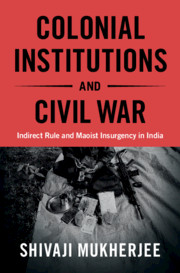Book contents
- Colonial Institutions and Civil War
- Cambridge Studies in Contentious Politics
- Colonial Institutions and Civil War
- Copyright page
- Contents
- Figures
- Tables
- Acknowledgments
- Part I Theory
- Part II Qualitative and Quantitative Testing
- Part III Generalizability
- 9 Explaining Partial Success of Maoists in Kerala and Karnataka
- 10 Frontiers of Empire: Indirect Rule and Insurgency in Burma and Pakistan
- 11 Conclusion: Policy Implications and Future of the Maoist Conflict
- Bibliography
- Index
- Series page
10 - Frontiers of Empire: Indirect Rule and Insurgency in Burma and Pakistan
from Part III - Generalizability
Published online by Cambridge University Press: 15 May 2021
- Colonial Institutions and Civil War
- Cambridge Studies in Contentious Politics
- Colonial Institutions and Civil War
- Copyright page
- Contents
- Figures
- Tables
- Acknowledgments
- Part I Theory
- Part II Qualitative and Quantitative Testing
- Part III Generalizability
- 9 Explaining Partial Success of Maoists in Kerala and Karnataka
- 10 Frontiers of Empire: Indirect Rule and Insurgency in Burma and Pakistan
- 11 Conclusion: Policy Implications and Future of the Maoist Conflict
- Bibliography
- Index
- Series page
Summary
Is my theory generalizable to other cases of British and Spanish colonial rule beyond India? I use historical data to show that the mechanisms of land and natural resource extraction and lower development seen in Chhattisgarh and Andhra Pradesh in India are found in other cases. The British used indirect rule in the "frontier" areas in Pakistan and Myanmar, which created structural conditions for insurgency. Within Pakistan, the Tehrik-e-Taliban insurgency since the mid-2000s in the Federally Administered Tribal Areas (FATA) in the North Western Frontier Province (NWFP) has occurred in areas of erstwhile British indirect rule. In Myanmar, there have been multiple ethnic secessionist insurgencies in the periphery that were frontier areas of indirect rule. My theory can also be generalized to Spanish colonialism in Latin America. I briefly describe two cases of Spanish colonial land tenure institutions creating land inequalities and leftist insurgency, one is the case of Spanish rule in Mexico, which created conditions for the Zapatista insurgency, and another case is of Spanish and then American rule in the Philippines that resulted in the New People’s Army (NPA) insurgency.
Keywords
- Type
- Chapter
- Information
- Colonial Institutions and Civil WarIndirect Rule and Maoist Insurgency in India, pp. 324 - 348Publisher: Cambridge University PressPrint publication year: 2021

